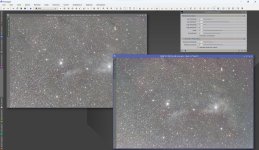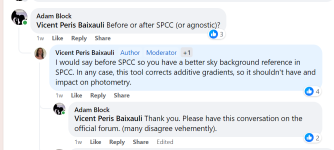@fredvanner @cloudbait @tom886 @robyx @vicent_peris @Juan Conejero @johnpane
As I have mentioned over and over there is needless disagreement on this.
I asked for the information the very second the tool was teased knowing this was going to be an issue.
Fred you malign me with mythmaking.
From the developers:
for this topic I think that I can give my two cents:
Speaking about SPCC, With color calibration we have primarily a multiplicative operation (the color calibration properly said) + an optional Additive operation (Background neutralization).
Let's forget Background neutralization for the moment.
With GradientCorrection we apply exclusively an additive correction that is automatically normalized (as for the "Normalize" checkbox in ABE/DBE).
Therefore SPCC and Additive gradient correction can be performed in any order you want, 'cause they are independent operations. (the only drawback in doing GC as second operation is that you will probably need to perform a new background neutralization after GC)
When you need to correct for Multiplicative gradient (I.E. Flat field missing or very strong differential extinction) then Gradient correction MUST be performed before Color calibration.
To simplify for "unskilled" users we can say that Gradient correction, in generale, should be done before color calibration: but this is a simplification of the problem.
Consider that if we have a mixed gradient (additive+multiplicative) at the moment we cannot separate the two component, so there's no correct answer, o better the answer should be:
1) multiplicative gradient
2) additive gradient and color calibration in any order (with a final background neutralization if needed).
But at the moment we don't have a tool that can separate additive and multiplicative gradients.
Edoardo Luca Radice
PixInsight Ambassador
Hi Adam,
Edoardo gave you good answers. I want to add two things:
- We are producing a video where we apply SPCC before and after applying GradientCorrection. The RGB weights of the second SPCC run are 1:0.997:0.997. This indicates that the subtractive gradient correction does not alter in any way the color calibration. Even if you have mixed multiplicative and additive gradients (the first ones will always decrease SPCC accuracy), GradientCorrection will leave the multiplicative factor in the same state.
Best regards,
Vicent.
And finally Juan tacitly agrees with the above.
So you want to claim a position on this? Fine. Take it up with the developers.
I do have an opinion on the nature of a FORUM. It is a forum of ideas that seeks to help others. Sometimes consensus is a good thing.
So to summarize.
1. GC does not affect multiplicative gradient (errors). You can do GC before or after SPCC without detriment. THIS is in direct contradiction and disagreement with Fred and Chris.
2. Furthermore, multiplicative gradients- if you want/need to correct them, require a different approach that comes *before* SPCC. (It is not clear to me if DBE with division can be helpful in this regard. However, most people don't know what errors they have.)
3. So we have GC which has any order and multiplicative errors that need to be corrected before SPCC.
4. Thus on the whole suggesting to correct gradients before SPCC (color calibration) appears to me a sensible answer.
I do not consider the above a "myth" (Fred) or "outdated or wrong" (Chris).
Bottom line, what is being explained to me makes sense. Vicent literally has examples (he says) that contradicts Fred's expectations. Increasing the scatter does not necessarily change the fit significantly I believe is what is being claimed. Showing your work is always a good thing.
Given all of this, I think I am being reasonable.
-adam


